Trending
Opinion: How will Project 2025 impact game developers?
The Heritage Foundation's manifesto for the possible next administration could do great harm to many, including large portions of the game development community.
Happy Halloween! From their ancient egyptian origins to their use in modern divination, and everything in between, today's history of game design will look at the full story of the mysterious Tarot deck.


The following article is a reproduction, and has been modified for this site. The original article, and many more, can be found at RemptonGames.com
Hello everybody, and welcome back to Rempton Games. Halloween is nearly upon us, so I’ve decided to do a special themed episode of History of Game Design to look at one of the spookiest game components out there – the Tarot deck. This deck is widely considered to have associations with magic and the occult, and many believe that carefully arranging and interpreting these cards in particular ways can be used to tell the future .
In Today’s History of Game Design I am going to going back to the origin of these mysterious and mystical cards to find out where they come from, how they were designed, and whether the rumors of magical power really do hold any truth.
In America we are all primarily familiar with one deck of cards – the 52 card deck made by companies like Bicycle. Numbers range from Ace to ten, there are three face cards – Kings, Queens, and Jacks, and four suits – Clubs and Spades are black, Hearts and Diamonds are red. This deck is probably what you think of when you simply hear the words “playing cards”, and is used to play games like Poker, War, Crazy Eights, and Go Fish. However, you may be surprised to discover that this type of playing card deck is only one of many that are commonly used around the world.
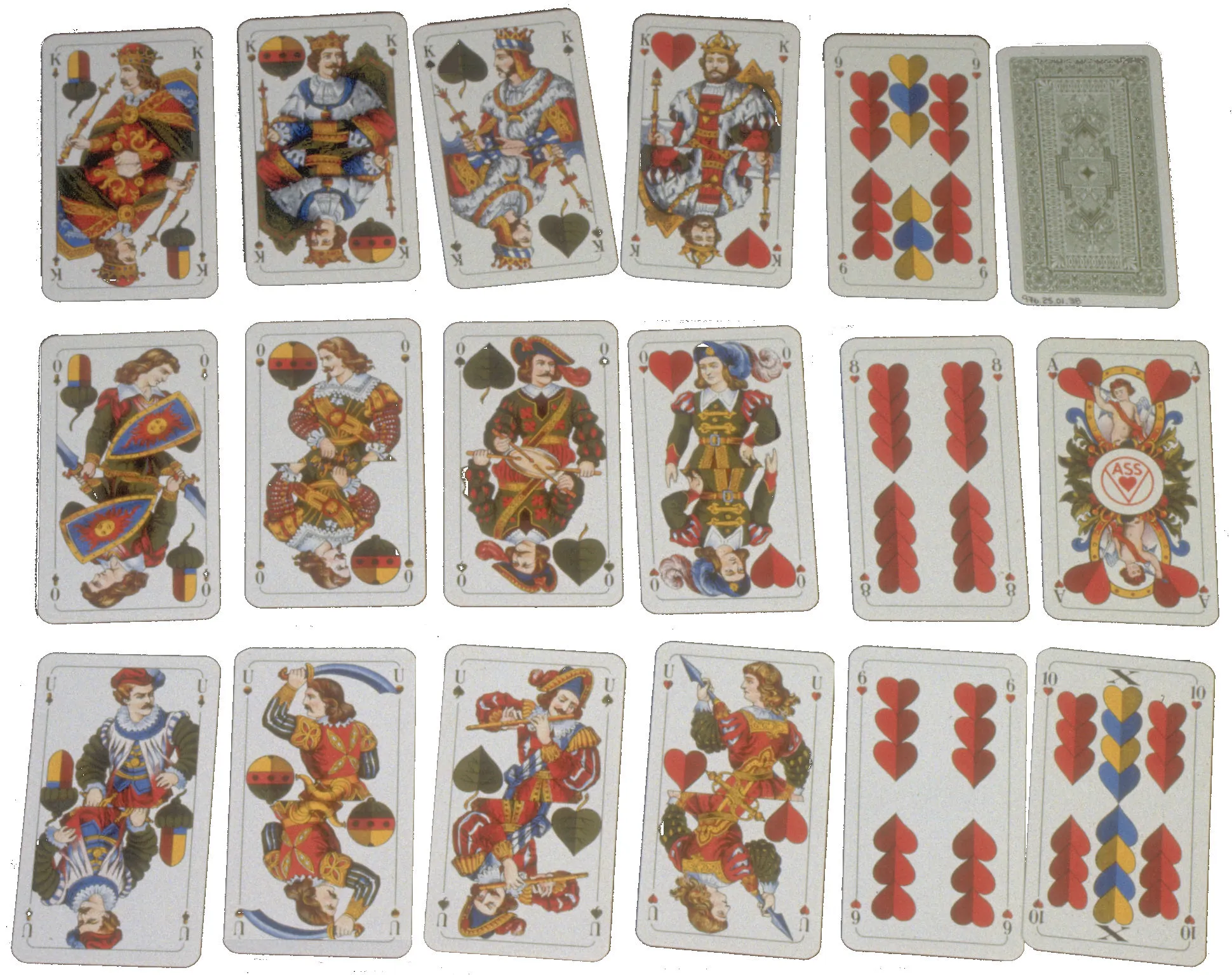 The deck we have been talking about is the French Deck, and is the most widespread variety of playing cards. However, it is far from the only one. The German Deck, for example, has suits of acorns, hearts, leaves and bells, and only have 32 cards because they don’t include the numbers from 2 to 6.
The deck we have been talking about is the French Deck, and is the most widespread variety of playing cards. However, it is far from the only one. The German Deck, for example, has suits of acorns, hearts, leaves and bells, and only have 32 cards because they don’t include the numbers from 2 to 6.
At it’s core, the Tarot deck is no different – it is simply a different way of defining the suits and values of a deck of playing cards. Like other decks, tarot decks typically have four suits. These suits vary somewhat, but the most common are probably the Wands, Swords, Cups, and Coins. Wands can sometimes be replaced with clubs or batons, and coins is sometimes replaced with Stars. Each of these suits has 10 numbered cards and four face-cards. These face cards can also vary – sometimes they are seen as knaves, knights, kings and queens, other times they are the Son, Daughter, Mother and Father.
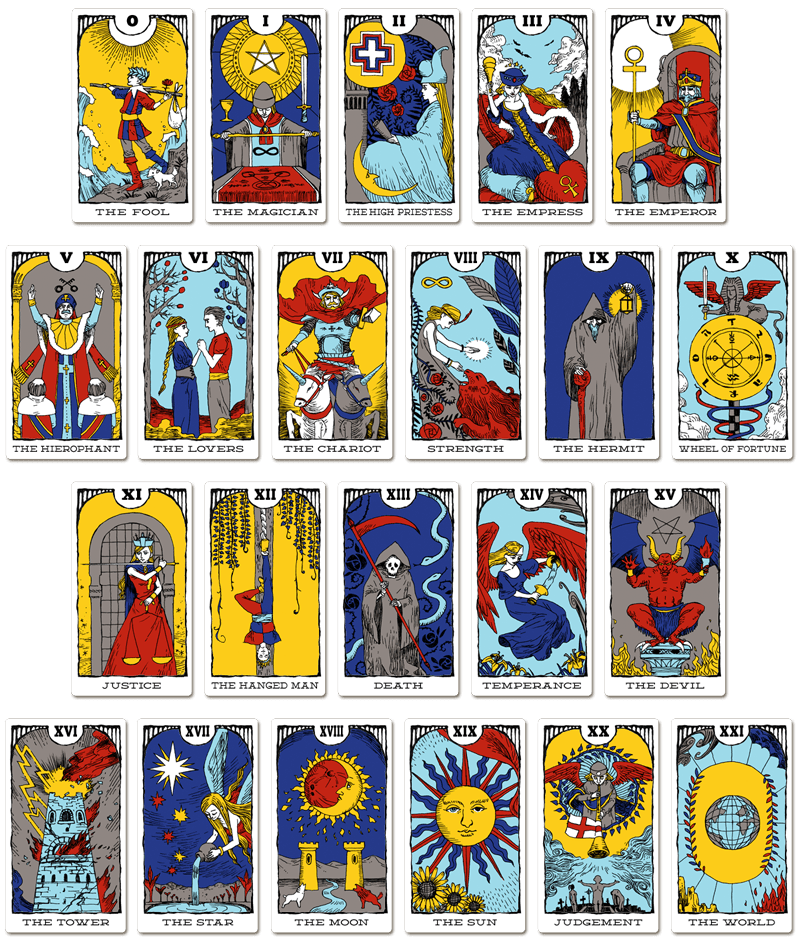 The main thing that sets the Tarot cards apart from other decks of cards is that is has a dedicated set of “Trump cards” that stand above the other cards. There are 21 of these trump cards, and instead of a suit each of these cards have individual names, ranging from Number 1: The Magician to Number 21: The World. There is also 1 additional card, The Fool, which is a special card with its own rules in most Tarot games. In occult decks the fool is often grouped in with the trumps, and given the number 0.
The main thing that sets the Tarot cards apart from other decks of cards is that is has a dedicated set of “Trump cards” that stand above the other cards. There are 21 of these trump cards, and instead of a suit each of these cards have individual names, ranging from Number 1: The Magician to Number 21: The World. There is also 1 additional card, The Fool, which is a special card with its own rules in most Tarot games. In occult decks the fool is often grouped in with the trumps, and given the number 0.
Decks that resemble modern playing cards have been found in Europe since the late 1300’s, and are thought to have been brought there from an area in Egypt known as Mamluk. These decks had many recognizable features, including four suits of the same size, which are similar to the suited cards in a tarot deck.
However, these decks would not truly become Tarot decks until around the mid 1400’s, when cards with allegorical illustrations began to be added to standard decks of playing cards. These decks became known as Trionfi, which means Triumph, and which evolved into the English word Trump. In the early days these decks would have been hand- painted and very rare, and no complete sets of these early Tarot decks have been found.
 Like most playing cards, Tarot cards were, and still are in much of Europe, used to play card games. Tarot decks are believed to have originated in Italy, and spread through much of Europe. As they spread the decks were often modified by the different regions, as were the rules of the games that were played. There are many varieties of Tarot games played around Europe in areas such as Italy, France, Germany and Switzerland, and while they all have slight differences much of the rules are the same. While these games never really caught on in English-speaking parts of the world, they are still widely played in many countries, particularly Italy and France.
Like most playing cards, Tarot cards were, and still are in much of Europe, used to play card games. Tarot decks are believed to have originated in Italy, and spread through much of Europe. As they spread the decks were often modified by the different regions, as were the rules of the games that were played. There are many varieties of Tarot games played around Europe in areas such as Italy, France, Germany and Switzerland, and while they all have slight differences much of the rules are the same. While these games never really caught on in English-speaking parts of the world, they are still widely played in many countries, particularly Italy and France.
To demonstrate how Tarot games are played, I am going to be using the example of French Tarot, which is one of the most popular Tarot games played today.
This game uses the full 78 card tarot deck – 14 cards of each of the four suits, 21 trumps, and the fool. Like most Tarot games, French Tarot is a trick-taking game, which means that the goal is to earn the most points by capturing cards in a series of rounds called Tricks, usually by playing a higher card than the rest of the players.
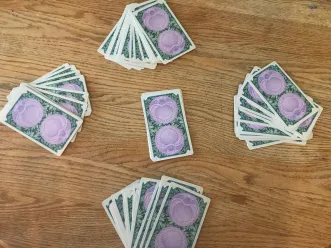 The game is usually played with four players, and each player is dealt 18 cards. There is also a separate pile of cards called the “dog” pile, which consists of six cards. Once players have their hands, the game enters the bidding phase. In this phase players evaluate the cards in their hand, and decide on how confident they are. There are several types of bids, each one indicating a higher degree of confidence in their hand.
The game is usually played with four players, and each player is dealt 18 cards. There is also a separate pile of cards called the “dog” pile, which consists of six cards. Once players have their hands, the game enters the bidding phase. In this phase players evaluate the cards in their hand, and decide on how confident they are. There are several types of bids, each one indicating a higher degree of confidence in their hand.
The player who wins the bid is considered to be the “taker”. The taker is trying to collect enough points to meet their “contract”, which means collecting a certain number of point cards. All the other players are the defense, and are trying to prevent the taker from achieving their goals.
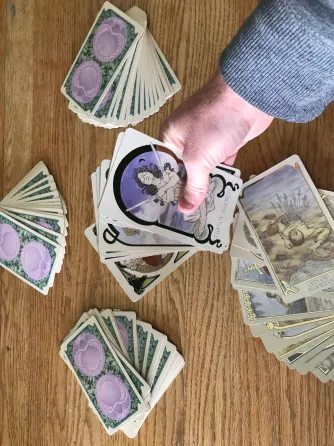 What happens to the “dog” pile depends on what type of bid the winner made. If the winner made a “push” bid, they are allowed to look at the dog pile, add it to their hand, and then add six cards from their hand to start their score pile. This type of bid shows the least confidence. Other bids could have the taker blindly adding the dog pile to their score without being able to look at it, or even adding it to their opponent’s score pile if they really believe in their hand.
What happens to the “dog” pile depends on what type of bid the winner made. If the winner made a “push” bid, they are allowed to look at the dog pile, add it to their hand, and then add six cards from their hand to start their score pile. This type of bid shows the least confidence. Other bids could have the taker blindly adding the dog pile to their score without being able to look at it, or even adding it to their opponent’s score pile if they really believe in their hand.
Players take turns leading the tricks, and whoever leads the trick will start by placing a card on the board. If that card was a suited card players are expected to follow suit. If a player cannot follow suit they can play a Trump instead. After everyone has played a card whoever played the highest card of the leading suit, or the highest Trump card, wins the trick, and adds those cards to their scoring pile.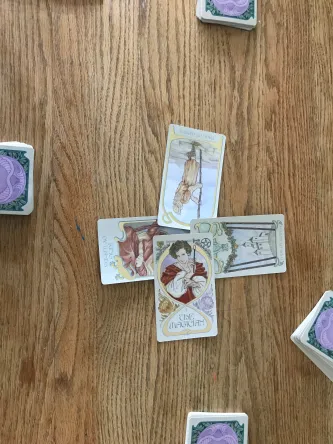
Once all the hands have been played, players count up the total number of points they have won. Each card has an individual point value – Kings are worth 4 ½ points, Queens are 3 ½ , Knights are worth 2 ½ , and Jacks are worth 1 ½. All other cards are worth ½ point. The exception is a group of three special cards called the “Honors”, which consists of the Fool, the 1 of Trumps (which is normally called “The magican” but in French decks is called “The Little One”), and the 21 of Trumps, “The World”.
These special “honors” are not only worth 4 ½ points (just like a King), but are also incredibly valuable because they reduce the total number of points the Taker has to collect in order to win. Without any honors the taker is expected to collect a total of 56 out of 91 possible points. If the taker collects all of the honors, on the other hand, they only need 36 points.
If the taker gets more than the minimum amount of points required to win the hand, the difference is added to the score, and this difference is also subtracted from the score of all of the defenders. If the taker fails, they lose points and all the defenders gain points. These point changes can also be multiplied depending on the type of bid that was made at the beginning.
While there are many different games that can be played with the tarot deck, most of them follow a similar formula to this one. Common differences include the number of players, the number of cards that are included in the deck, the role of the “Fool” card, and specifics about scoring.
So far I have mostly been discussing Tarot cards as a game component, but in many places (including the United States) tarot cards are much better known for their association with magic and the occult. While this topic is large enough for several videos on its own (and you can definitely let me know in the comments if you would like me to dig into it more in the future), because this is a History of Game Design I will briefly look at where this association with mysticism comes from, and how it has evolved in the modern day.
Almost from their earliest invention card games were considered to be immoral instruments by some, usually due to their associations with gambling and games of chance. Tarot games were certainly included among this, and sermons speaking out against the sins of card games can be found throughout the 16th and 17th centuries. However, these sermons generally did not speak out against the Trump cards specifically, and were not focused on the cards as a tool of sorcery or mysticism.
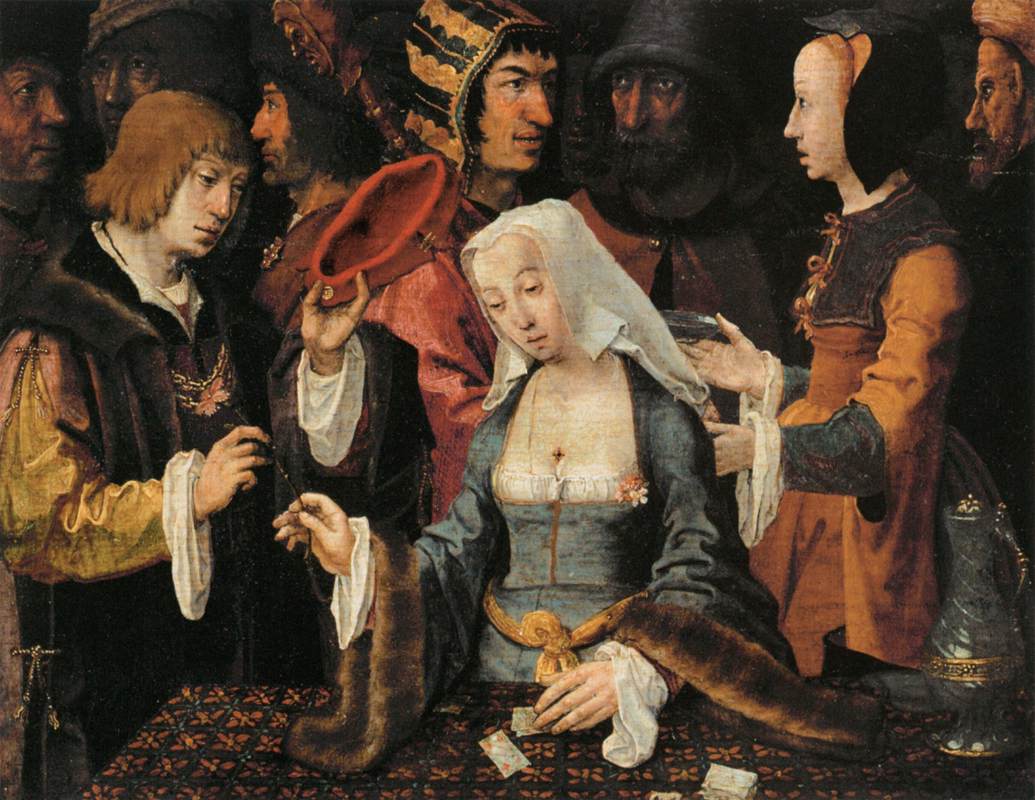 The use of playing cards for divination, known as Cartomancy, has references dating back possibly as far as the 1400’s, and we certainly quite widespread by the mid 1700s. While the use of playing cards to fortune telling may seem like a bit of a leap, it is actually quite a natural step to make. Throughout human history nearly anything that had an element of repeatable randomness, from dice to butchered animals, was used for fortune telling. Playing cards would have been quite natural for this purpose as not only are they random, but the various numbers, suits, and face cards would make it easy to assign clear and symbolic meanings to each card.
The use of playing cards for divination, known as Cartomancy, has references dating back possibly as far as the 1400’s, and we certainly quite widespread by the mid 1700s. While the use of playing cards to fortune telling may seem like a bit of a leap, it is actually quite a natural step to make. Throughout human history nearly anything that had an element of repeatable randomness, from dice to butchered animals, was used for fortune telling. Playing cards would have been quite natural for this purpose as not only are they random, but the various numbers, suits, and face cards would make it easy to assign clear and symbolic meanings to each card.
Surprisingly, the first cards used for Cartomancy were actually the standard French deck, rather than the Tarot deck. The use of the Tarot deck for Cartomancy goes back to the 1780s, several decades later. In fact, among non-english speaking countries regular playing cards were the most common decks used for cartomancy up until the mid 20th century.
However, the addition of the Trumps and the Fool cards in the Tarot deck do make it particularly suited for divination purposes. While it is easy to assign meanings to regular playing cards, Tarot cards such as “The Wheel of Fortune”, “The Hanged Man”, and “Judgement” are so evocative that its almost hard NOT to try to assign meaning to them.
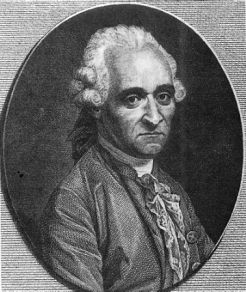 The first record of somebody trying to assign particular mystical meanings to these cards goes back to a French clergyman named Antoine Court de Gébelin in 1781. He was the first to create a link between Tarot cards and Egyptian mythology for, as far as I can tell, no reason other than the fact that these cards were so compelling to him that he believed they must have some higher meaning. He began to associate particular cards with mythological figures such as Isis and Osiris, and even went as far as to claim that the word Tarot was derived from ancient Egyptian and meant “Royal Road of Life” – a fact that future Egyptologists were able to find no evidence for.
The first record of somebody trying to assign particular mystical meanings to these cards goes back to a French clergyman named Antoine Court de Gébelin in 1781. He was the first to create a link between Tarot cards and Egyptian mythology for, as far as I can tell, no reason other than the fact that these cards were so compelling to him that he believed they must have some higher meaning. He began to associate particular cards with mythological figures such as Isis and Osiris, and even went as far as to claim that the word Tarot was derived from ancient Egyptian and meant “Royal Road of Life” – a fact that future Egyptologists were able to find no evidence for.
Despite the lack of evidence behind his claims, Court de Gebelin’s work was very influential, and still colors much of Tarot divination today. Later authors would build upon this work, even claiming that the tarot cards themselves are the “Book of Thoth” – a mythological book supposedly written by Thoth, the Egyptian god of wisdom.
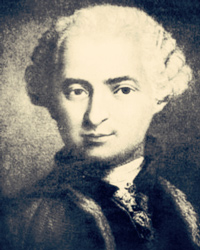 Only a few short years later, Jean-Baptiste Alliette was the first to assign meanings to the cards in the context of divination, as well as create the first Tarot society and the first Tarot deck specifically for the purpose of divination. In addition to discussing the Book of Thoth, Alliette created a number of other theories about Tarot cards including the belief that they describe the creation of the universe and that the first tarot cards were printed on leaves made of gold.
Only a few short years later, Jean-Baptiste Alliette was the first to assign meanings to the cards in the context of divination, as well as create the first Tarot society and the first Tarot deck specifically for the purpose of divination. In addition to discussing the Book of Thoth, Alliette created a number of other theories about Tarot cards including the belief that they describe the creation of the universe and that the first tarot cards were printed on leaves made of gold.
Later authors would come up with even further theories for the origins and meanings of Tarot cards. Éliphas Lévi, in the early to mid 1800s, claimed that Tarot cards were older than Moses, connected the 10 numbered cards to the Sephirot in Jewish Kabbalah, and claimed that the four suits represented the four-letter name of god.
These days there are an endless number of mystical theories about the origins and purpose of the Tarot deck, but in many of them the interpretations are largely the same. One very common modern interpretation of the Tarot deck, specifically the Major Arcana which consists of the Trump cards plus the fool, is known as the “Fool’s Journey”.
According to this interpretation the entire Major Arcana is the story of the fool, which represents “the everyman”, as he makes his way towards enlightenment, represented by “The World”. The various other cards represent people that he meets, or events that occur along the way.
That is all I have for this week. If you enjoyed this article, check out the rest of the blog and subscribe on Twitter, Youtube, or here on WordPress so you will always know when I post a new article. If you didn’t, let me know what I can do better in the comments down below. And join me next time for a look at the importance of designing interesting choices in games!
Read more about:
BlogsYou May Also Like